World Roundup
September/October 2016


-
 WASHINGTON: As far as the U.S. Army Corps of Engineers is concerned, the controversial saga of Kennewick Man is near its end. The 8,000-year-old skeletal remains found in the Columbia River in 1996 have been the subject of legal challenges since it was suggested, based on physical evidence, that they might not be Native American in origin. According to the latest research, the Corps has determined that Kennewick Man is indeed Native American, opening the door for his return to one of the tribes that claims a connection. —Samir S. Patel
WASHINGTON: As far as the U.S. Army Corps of Engineers is concerned, the controversial saga of Kennewick Man is near its end. The 8,000-year-old skeletal remains found in the Columbia River in 1996 have been the subject of legal challenges since it was suggested, based on physical evidence, that they might not be Native American in origin. According to the latest research, the Corps has determined that Kennewick Man is indeed Native American, opening the door for his return to one of the tribes that claims a connection. —Samir S. Patel -
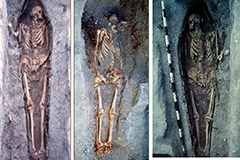 ANTIGUA AND BARBUDA: Life was difficult for the British sailors stationed in the Caribbean during the Napoleonic Wars. Many died from disease, and it is suspected many also fell victim to heavy metal poisoning. Analysis of remains from the cemetery of the Royal Naval Hospital in Antigua revealed lead poisoning—in some cases severe enough to contribute to death. Potential sources of the toxic metal could be linings of water systems, medicines, and, perhaps most notably, rum distilled using lead coils. —Samir S. Patel
ANTIGUA AND BARBUDA: Life was difficult for the British sailors stationed in the Caribbean during the Napoleonic Wars. Many died from disease, and it is suspected many also fell victim to heavy metal poisoning. Analysis of remains from the cemetery of the Royal Naval Hospital in Antigua revealed lead poisoning—in some cases severe enough to contribute to death. Potential sources of the toxic metal could be linings of water systems, medicines, and, perhaps most notably, rum distilled using lead coils. —Samir S. Patel -
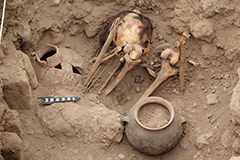 PERU: There are two basic means for an imperial power to impose its will: by replacing the original population or through diffusion of the imperial culture. To examine the rise of the Wari Empire (A.D. 600–1100) in the Andes, geneticists studied DNA from 34 burials at the Huaca Pucllana site dating to before, during, and after Wari rule. The results show only subtle changes in genetic diversity, suggesting that at this site, the Wari did not decimate the people of the Lima culture who already lived there. —Samir S. Patel
PERU: There are two basic means for an imperial power to impose its will: by replacing the original population or through diffusion of the imperial culture. To examine the rise of the Wari Empire (A.D. 600–1100) in the Andes, geneticists studied DNA from 34 burials at the Huaca Pucllana site dating to before, during, and after Wari rule. The results show only subtle changes in genetic diversity, suggesting that at this site, the Wari did not decimate the people of the Lima culture who already lived there. —Samir S. Patel -
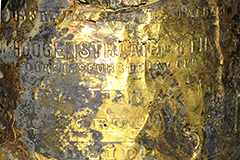 THE NETHERLANDS: Outside of caviar, perhaps, only a very few delicacies come in cans. Construction workers at a railway tunnel site stumbled on the remains of just such a treat: a can of turtle soup dating to between 1860 and 1900. The dish has lost popularity in the West for various reasons—the taste, the fact that some are endangered species—but was once coveted enough to grace the tables of European royalty, possibly because turtles aren’t native to northwestern Europe. —Samir S. Patel
THE NETHERLANDS: Outside of caviar, perhaps, only a very few delicacies come in cans. Construction workers at a railway tunnel site stumbled on the remains of just such a treat: a can of turtle soup dating to between 1860 and 1900. The dish has lost popularity in the West for various reasons—the taste, the fact that some are endangered species—but was once coveted enough to grace the tables of European royalty, possibly because turtles aren’t native to northwestern Europe. —Samir S. Patel -
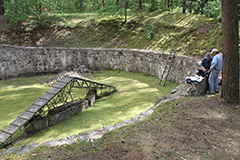 LITHUANIA: As many as 100,000 people were executed at Ponar, a Nazi killing site, beginning six months before Adolf Eichmann proposed the “Final Solution.” New remote sensing studies of the site have uncovered evidence of several massive burial pits, as well as a 100-foot-long tunnel, dug by spoon and hand, through which a dozen prisoners, who were being forced to exhume burial pits and burn evidence of the killings, managed to escape on the last day of Passover in 1944. Eleven survived the war to provide testimony of the atrocities. —Samir S. Patel
LITHUANIA: As many as 100,000 people were executed at Ponar, a Nazi killing site, beginning six months before Adolf Eichmann proposed the “Final Solution.” New remote sensing studies of the site have uncovered evidence of several massive burial pits, as well as a 100-foot-long tunnel, dug by spoon and hand, through which a dozen prisoners, who were being forced to exhume burial pits and burn evidence of the killings, managed to escape on the last day of Passover in 1944. Eleven survived the war to provide testimony of the atrocities. —Samir S. Patel -
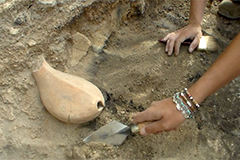 GEORGIA: In traditional Georgian banquets today, guests engage in elaborate toasts involving wine drunk from animal-horn vessels. Archaeologists at the site of Aradetis Orgora recently discovered a jar and two animal-shaped clay vessels, one containing pollen from the common grape vine. Belonging to the Kura-Araxes culture and dating to 5,000 years ago (and therefore probably not related to modern traditions), the jar might have been used to decant wine into the vessels for ritual consumption. —Samir S. Patel
GEORGIA: In traditional Georgian banquets today, guests engage in elaborate toasts involving wine drunk from animal-horn vessels. Archaeologists at the site of Aradetis Orgora recently discovered a jar and two animal-shaped clay vessels, one containing pollen from the common grape vine. Belonging to the Kura-Araxes culture and dating to 5,000 years ago (and therefore probably not related to modern traditions), the jar might have been used to decant wine into the vessels for ritual consumption. —Samir S. Patel -
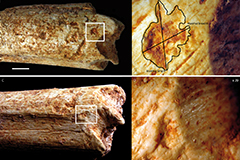 MOROCCO: Early humans certainly competed with large carnivores for resources, including prey and the natural shelter of caves, but there is little direct evidence for their interaction before the Upper Paleolithic (roughly 50,000 to 10,000 years ago), when humans began hunting carnivores in numbers. A hominin bone belonging to the species Homo rhodesiensis and around 500,000 years old, found among a large deposit of bones in a cave in Casablanca, had been cracked, gnawed, and punctured—probably by an extinct hyena. The find shows how easily humans and large carnivores could change places on the food chain. —Samir S. Patel
MOROCCO: Early humans certainly competed with large carnivores for resources, including prey and the natural shelter of caves, but there is little direct evidence for their interaction before the Upper Paleolithic (roughly 50,000 to 10,000 years ago), when humans began hunting carnivores in numbers. A hominin bone belonging to the species Homo rhodesiensis and around 500,000 years old, found among a large deposit of bones in a cave in Casablanca, had been cracked, gnawed, and punctured—probably by an extinct hyena. The find shows how easily humans and large carnivores could change places on the food chain. —Samir S. Patel -
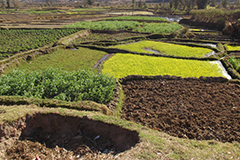 MADAGASCAR: This island nation is 300 miles from the coast of Africa and 3,700 miles from Southeast Asia, but the people there speak Malagasy, an Austronesian language related to Malay and Hawaiian. This suggests that the island was colonized around 1,200 years ago from across the Indian Ocean, but until now there was no physical evidence to back up the linguistic and genetic data. Recently excavated botanical remains have provided the first tangible link—the remains of Asian crops, including rice and cotton—at sites there and on the Comoros islands closer to the African mainland. —Samir S. Patel
MADAGASCAR: This island nation is 300 miles from the coast of Africa and 3,700 miles from Southeast Asia, but the people there speak Malagasy, an Austronesian language related to Malay and Hawaiian. This suggests that the island was colonized around 1,200 years ago from across the Indian Ocean, but until now there was no physical evidence to back up the linguistic and genetic data. Recently excavated botanical remains have provided the first tangible link—the remains of Asian crops, including rice and cotton—at sites there and on the Comoros islands closer to the African mainland. —Samir S. Patel -
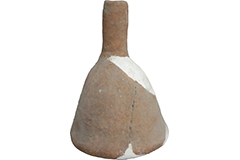 CHINA: Broomcorn, millet, barley, Job’s tears, tubers—this ancient Chinese beer recipe probably produced an interesting bouquet. The ingredients were identified from residues found in a variety of clay vessels, including a funnel, that may have comprised a “beer-making toolkit” from a 5,000-year-old site in Shaanxi. The find is also the earliest known identification of barley in the country, suggesting the grain was introduced for beer production rather than as food. —Samir S. Patel
CHINA: Broomcorn, millet, barley, Job’s tears, tubers—this ancient Chinese beer recipe probably produced an interesting bouquet. The ingredients were identified from residues found in a variety of clay vessels, including a funnel, that may have comprised a “beer-making toolkit” from a 5,000-year-old site in Shaanxi. The find is also the earliest known identification of barley in the country, suggesting the grain was introduced for beer production rather than as food. —Samir S. Patel -
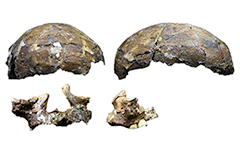 MALAYSIA: The “Deep Skull,” found in 1958, is still the earliest known remnant of a modern human in island Southeast Asia, at 37,000 years old. It had been thought that the skull, from Borneo, came from someone related to indigenous Australians, and that the islands were settled in two waves—first by ancestors to Australians and then by immigrants from Asia who became Borneo’s modern indigenous people. A new analysis, however, found that the skull appears to be more Asian than Australian in origin, suggesting there was just one major migration. —Samir S. Patel
MALAYSIA: The “Deep Skull,” found in 1958, is still the earliest known remnant of a modern human in island Southeast Asia, at 37,000 years old. It had been thought that the skull, from Borneo, came from someone related to indigenous Australians, and that the islands were settled in two waves—first by ancestors to Australians and then by immigrants from Asia who became Borneo’s modern indigenous people. A new analysis, however, found that the skull appears to be more Asian than Australian in origin, suggesting there was just one major migration. —Samir S. Patel
Advertisement
IN THIS ISSUE
Features
A New View of the Birthplace of the Olympics
Romans on the Bay of Naples
Worlds Within Us
Letter from Rotterdam
From the Trenches
Piecing Together a Plan of Ancient Rome
Off the Grid
Gimme Middle Paleolithic Shelter
Zapotec Power Rites
Mystery Buildings at Petra
Sun and Moon
The Great Parallelogram
The Prisoners of Richmond Castle
A True Viking Saga
Culture Clash
Lost and Found (Again)
The City That Wasn’t
Mask Metamorphosis
Advertisement

Recent Issues
-
 May/June 2024
May/June 2024
-
 March/April 2024
March/April 2024
-
 January/February 2024
January/February 2024
-
 November/December 2023
November/December 2023
-
 September/October 2023
September/October 2023
-
 July/August 2023
July/August 2023
-
 May/June 2023
May/June 2023
-
 March/April 2023
March/April 2023
-
 January/February 2023
January/February 2023
-
 November/December 2022
November/December 2022
-
 September/October 2022
September/October 2022
-
 July/August 2022
July/August 2022
-
 May/June 2022
May/June 2022
-
 March/April 2022
March/April 2022
-
 January/February 2022
January/February 2022
-
 November/December 2021
November/December 2021
-
 September/October 2021
September/October 2021
-
 July/August 2021
July/August 2021
-
 May/June 2021
May/June 2021
-
 March/April 2021
March/April 2021
-
 January/February 2021
January/February 2021
-
 November/December 2020
November/December 2020
-
 September/October 2020
September/October 2020
-
 July/August 2020
July/August 2020
-
 May/June 2020
May/June 2020
-
 March/April 2020
March/April 2020
-
 January/February 2020
January/February 2020
-
 November/December 2019
November/December 2019
-
 September/October 2019
September/October 2019
-
 July/August 2019
July/August 2019
-
 May/June 2019
May/June 2019
-
 March/April 2019
March/April 2019
-
 January/February 2019
January/February 2019
-
 November/December 2018
November/December 2018
-
 September/October 2018
September/October 2018
-
 July/August 2018
July/August 2018
-
 May/June 2018
May/June 2018
-
 March/April 2018
March/April 2018
-
 January/February 2018
January/February 2018
-
 November/December 2017
November/December 2017
-
 September/October 2017
September/October 2017
-
 July/August 2017
July/August 2017
-
 May/June 2017
May/June 2017
-
 March/April 2017
March/April 2017
-
 January/February 2017
January/February 2017
-
 November/December 2016
November/December 2016
-
 September/October 2016
September/October 2016
-
 July/August 2016
July/August 2016
-
 May/June 2016
May/June 2016
-
 March/April 2016
March/April 2016
-
 January/February 2016
January/February 2016
-
 November/December 2015
November/December 2015
-
 September/October 2015
September/October 2015
-
 July/August 2015
July/August 2015
-
 May/June 2015
May/June 2015
-
 March/April 2015
March/April 2015
-
 January/February 2015
January/February 2015
-
 November/December 2014
November/December 2014
-
 September/October 2014
September/October 2014
-
 July/August 2014
July/August 2014
-
 May/June 2014
May/June 2014
-
 March/April 2014
March/April 2014
-
 January/February 2014
January/February 2014
-
 November/December 2013
November/December 2013
-
 September/October 2013
September/October 2013
-
 July/August 2013
July/August 2013
-
 May/June 2013
May/June 2013
-
 March/April 2013
March/April 2013
-
 January/February 2013
January/February 2013
-
 November/December 2012
November/December 2012
-
 Sep/Oct 2012
Sep/Oct 2012
-
 September/October 2012
September/October 2012
-
 July/August 2012
July/August 2012
-
 May/June 2012
May/June 2012
-
 March/April 2012
March/April 2012
-
 January/February 2012
January/February 2012
-
 November/December 2011
November/December 2011
-
 September/October 2011
September/October 2011
-
 July/August 2011
July/August 2011
-
 May/June 2011
May/June 2011
-
 March/April 2011
March/April 2011
-
 January/February 2011
January/February 2011
Advertisement






